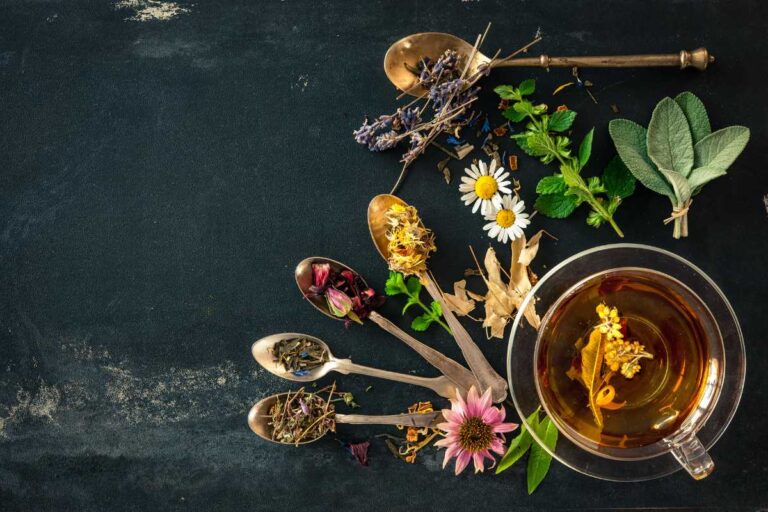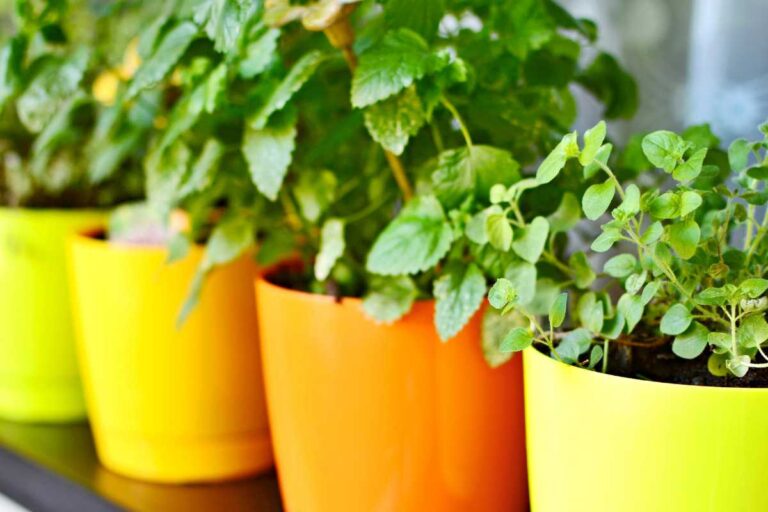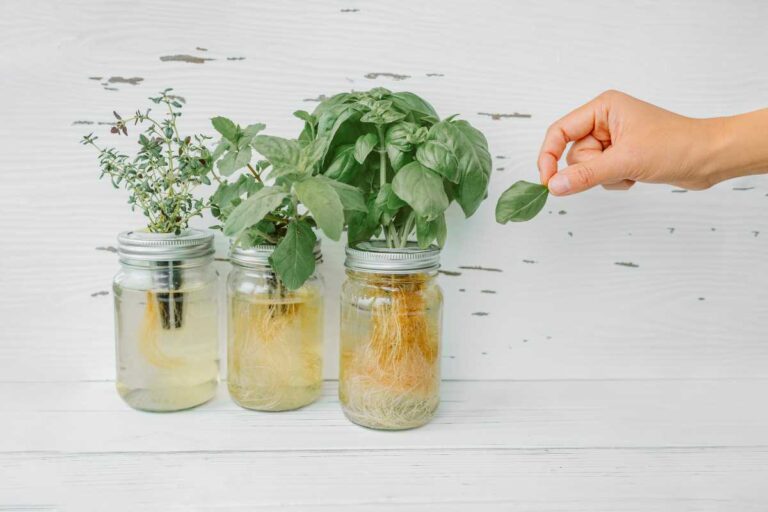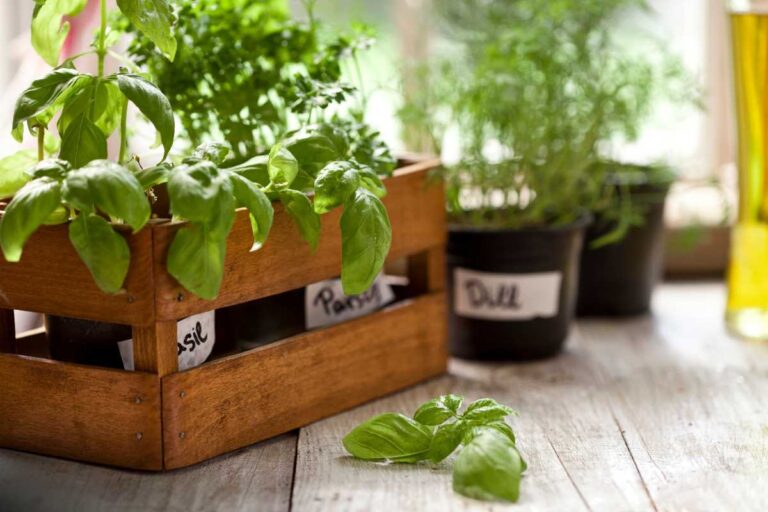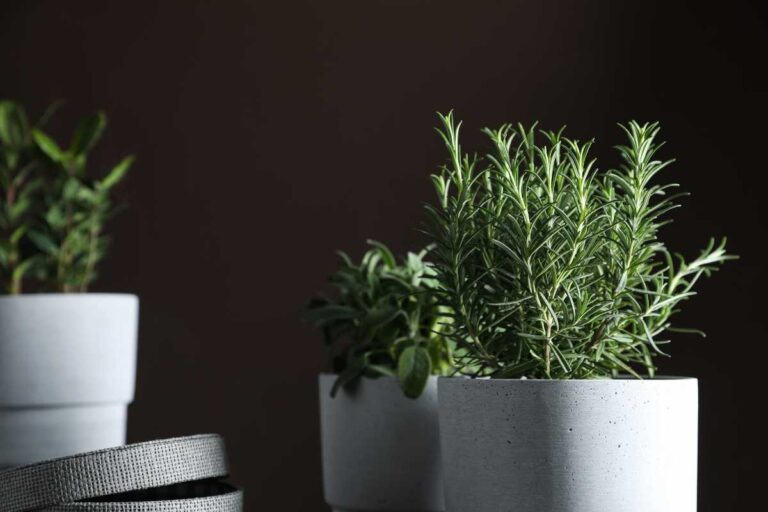Best Indoor Herb Garden Ideas: Top 10 for Year-round Fresh Herbs
Best Indoor Herb Garden Ideas: Top 10 for Year-round Fresh Herbs

Indoor herb gardens have become increasingly popular among urban dwellers seeking to enhance their cooking and home decor. With a wide range of indoor herb garden ideas available, it’s easier than ever to bring the freshness and flavor of herbs indoors.
Gone are the days when one needed a sprawling outdoor garden to grow their favorite herbs. Indoor herb gardens offer a convenient solution for those with limited space or unfavorable weather conditions. Not only do they provide easy access to fresh herbs year-round, but they also add a touch of greenery and natural beauty to any living space.
But why exactly are indoor herb gardens gaining such popularity? Well, aside from the obvious benefits of having your favorite herbs readily available for culinary creations, indoor herb gardening offers several advantages. It allows you to control the growing conditions, ensuring optimal growth and health for your plants. Moreover, it can improve air quality by filtering toxins and releasing oxygen into your home.
Whether you’re an experienced gardener or just starting out, there’s something here for everyone.
Tired of struggling with outdoor herb gardens in unpredictable weather? Discover the secret to successful herbal gardening indoors and enjoy fresh herbs year-round. Check out our article now!
Easy Minute Indoor Herb Planters
Starting your own indoor herb garden doesn’t have to be a daunting task. In fact, there are plenty of quick and hassle-free ways to get started. Whether you have limited space or lack a green thumb, these easy minute indoor herb planters will help you bring fresh herbs into your home without much effort.
Low-Maintenance Herbs That Thrive in Small Planters
Choosing the right herbs is essential. Opt for low-maintenance herbs that thrive in small planters and require minimal care. Here are a few examples:
- Basil: This aromatic herb is not only delicious but also easy to grow indoors. It prefers bright light and well-drained soil.
- Mint: Mint is known for its refreshing flavor and fragrance. It grows well in containers and can tolerate lower light conditions.
- Chives: Chives are versatile herbs that add a mild onion-like flavor to dishes. They are resilient and can adapt to various growing conditions.
- Parsley: Parsley is a popular culinary herb that adds freshness to many dishes. It thrives in containers with moist soil and moderate sunlight.
Creative Ideas for Repurposing Everyday Items as Herb Planters
Don’t limit yourself to traditional planters. Get creative and repurpose everyday items as unique containers for your herbs. Here are some ideas:
- Mason Jars: Mason jars make charming herb planters and can be easily hung on walls or placed on windowsills.
- Teacups: Old teacups or coffee mugs can be transformed into adorable mini herb gardens.
- Tin Cans: Cleaned tin cans can be painted or decorated with adhesive paper to create stylish planters for your herbs.
- Hanging Baskets: Utilize hanging baskets to maximize vertical space and create a stunning herb display in your kitchen.
Easy Minute Indoor Herb Planters
Now that you have an idea of the low-maintenance herbs and creative containers, let’s explore some easy minute indoor herb planters:
- Mason Jar Herb Garden: Fill mason jars with potting soil, plant your chosen herbs, and place them near a sunny window.
- Hanging Teacup Garden: Drill small holes at the bottom of teacups, add pebbles for drainage, fill with soil, and plant your herbs. Hang them using twine or wire.
- Tin Can Herb Planters: Decorate tin cans as desired, drill drainage holes at the bottom, fill with soil, and plant your favorite herbs.
- Vertical Hanging Basket Garden: Attach hanging baskets to a wall or ceiling using hooks or brackets. Plant different herbs in each basket for a visually appealing display.
Remember to water your indoor herb garden regularly but avoid overwatering as it can lead to root rot. Also, ensure that your plants receive adequate sunlight according to their specific requirements.
With these easy minute indoor herb planters, you can enjoy fresh herbs right at your fingertips without much effort. Get creative with repurposed containers and choose low-maintenance herbs that suit your taste preferences. Happy gardening!
Stylish Herb Displays with Painted Mason Jars
Looking to add a touch of style to your indoor herb garden? Look no further than painted mason jars! These versatile containers not only provide a practical way to grow and display your fresh herbs but can also be customized to match any home decor style. Let’s explore some easy techniques for painting and decorating mason jars that will take your herb garden to the next level.
Easy Techniques for Painting and Decorating Mason Jars
Painting mason jars is a fun and creative way to personalize your indoor herb garden. Here are some simple techniques you can try:
- Solid Color: Start by applying a base coat of acrylic paint in the color of your choice. Once dry, you can leave it as is or add additional decorative elements like stencils or stickers.
- Ombré Effect: Create a beautiful gradient effect by using multiple shades of the same color. Begin with one color at the bottom of the jar and gradually blend into another shade towards the top.
- Chalkboard Finish: Give your mason jars a rustic look by using chalkboard paint. This allows you to write directly on the jar, making it easy to label your herbs or change them as needed.
- Decoupage: Add charm to your herb garden by decoupaging patterned paper or fabric onto the surface of the jar. Apply a layer of decoupage glue over the material for durability.
- Dipped Effect: Achieve a modern and sleek look by partially dipping your mason jar into paint, leaving part of it unpainted for contrast.
Complementing Any Home Decor Style
One of the great things about painted mason jars is their versatility in matching different home decor styles. Whether you have a farmhouse-inspired kitchen or prefer minimalist aesthetics, there’s an option for everyone:
- Farmhouse Chic: Opt for distressed finishes or neutral colors like white, cream, or pastels to achieve that rustic farmhouse look.
- Modern and Sleek: Choose bold and vibrant colors such as metallics or high-gloss paints to make a statement in your contemporary space.
- Bohemian Vibes: Embrace eclectic patterns, bright hues, and intricate designs to create a boho-inspired herb garden display.
- Minimalist Elegance: Stick with monochromatic color schemes or simple patterns for a clean and minimalist aesthetic.
The Benefits of Painted Mason Jars for Your Herb Garden
Using painted mason jars in your indoor herb garden offers several advantages:
- Customization: With various painting techniques and color choices, you can personalize your herb garden to reflect your unique style and taste.
- Organization: By labeling each jar with the name of the herb, you can easily identify and locate specific plants in your garden.
- Decoration: Painted mason jars not only serve as functional plant pots but also double as decorative elements that add visual interest to any space.
- Reusability: Mason jars are durable and reusable containers. If you decide to change the herbs you’re growing or want to switch up your decor, simply repaint the jars for a fresh new look.
So why settle for plain pots when you can elevate your indoor herb garden with painted mason jars?
Utilizing Shoe Organizers for Herb Growing
If you’re tight on space but still want to grow your own herbs, why not consider using shoe organizers as a vertical herb garden? This creative solution allows you to maximize your available space and enjoy fresh herbs right at your fingertips. Let’s explore some different types of shoe organizers suitable for growing herbs and learn some tips and tricks for organizing and maintaining an efficient shoe organizer herb garden.
Types of Shoe Organizers for Herb Growing
There are a few options to consider. Here are some popular choices:
- Over-the-door Shoe Organizer: These organizers typically have clear pockets that allow you to see each herb plant easily. They can be hung on the back of a door or even on a wall, saving valuable floor space.
- Hanging Pocket Shoe Organizer: Similar to over-the-door organizers, these pocket-style organizers can be hung from hooks or rods. They provide individual compartments for each herb plant, keeping them separated and organized.
- Vertical Garden Shoe Organizer: These specialized shoe organizers are designed specifically for gardening purposes. They feature larger pockets with built-in drainage holes, allowing excess water to escape easily.
Tips and Tricks for Maintaining Your Shoe Organizer Herb Garden
Once you’ve chosen the perfect shoe organizer for your herb garden, it’s important to know how to maintain it properly. Here are some tips and tricks:
- Ensure Proper Drainage: While most shoe organizers have built-in drainage holes, it’s essential to double-check before planting your herbs. If there aren’t any drainage holes, make sure to create some by poking small holes in the bottom of each pocket.
- Use Quality Potting Soil: To provide optimal growing conditions for your herbs, use high-quality potting soil that is well-draining and nutrient-rich.
- Water Carefully: It’s important not to overwater your herbs, as this can lead to root rot. Check the moisture level of the soil regularly and only water when it feels dry to the touch.
- Rotate Your Shoe Organizer: To ensure that all your herbs receive adequate sunlight, rotate your shoe organizer every few days. This will prevent any one side from becoming overshadowed and promote even growth.
- Harvest Regularly: Don’t be afraid to snip off a few leaves or sprigs from your herbs regularly. This not only encourages bushier growth but also allows you to enjoy fresh herbs in your cooking.
High-Tech Herb Garden Solutions: Aerogarden Harvest Elite
If you’re looking to experience the convenience of high-tech indoor gardening, then the Aerogarden Harvest Elite is the perfect solution for you. This smart hydroponic system provides optimal conditions for herb growth, making it easier than ever to have fresh herbs right at your fingertips. Let’s dive into what makes the Aerogarden Harvest Elite stand out from other options.
Optimal Conditions for Herb Growth
The Aerogarden Harvest Elite utilizes a hydroponic system, which means that plants grow without soil. Instead, they receive all their necessary nutrients through water and a nutrient-rich solution. This method allows for faster growth and healthier plants compared to traditional soil-based gardening.
One of the standout features of this high-tech herb garden is its self-watering capability. The system automatically waters your herbs, ensuring they receive just the right amount of water without any guesswork or risk of overwatering. This not only saves you time but also helps prevent common issues like root rot.
Advanced Features
The Aerogarden Harvest Elite comes equipped with advanced features that set it apart from other indoor gardening options. Here are some key highlights:
- LED Grow Lights: The system uses energy-efficient LED lights that mimic natural sunlight, providing your herbs with the optimal amount and spectrum of light they need for healthy growth. These lights can be adjusted to different heights as your plants grow.
- Control Panel: The control panel on the Aerogarden Harvest Elite allows you to easily monitor and adjust settings such as light intensity and watering schedule. It even reminds you when it’s time to add more water or nutrients.
- Seed Pods: The system includes pre-seeded pods that contain a variety of popular herb seeds such as basil, mint, and cilantro. Simply insert these pods into the designated slots, and watch your herbs sprout in no time.
- Gourmet Herb Seed Kit: For those looking to expand their herb collection, the Aerogarden Harvest Elite offers a Gourmet Herb Seed Kit. This kit includes a wide range of herb seeds, allowing you to experiment with different flavors and aromas.
Pros and Cons
Pros:
- Easy to use, even for beginners.
- Saves space and eliminates the need for outdoor gardening.
- Provides fresh herbs year-round, regardless of the season.
- Energy-efficient LED lights help reduce electricity consumption.
Cons:
- Initial investment may be higher compared to traditional gardening methods.
- Limited space for larger plants or vegetables.
Creating Unique Herb Gardens with Upcycled Containers
If you’re looking for a creative and eco-friendly way to grow your own herbs, why not try upcycling containers into unique herb gardens? Not only will this add a touch of personality to your space, but it’s also a great way to repurpose items that would otherwise end up in the trash. Let’s explore some innovative ideas and learn how to prepare and repurpose different containers for successful herb cultivation.
Get inspired by innovative ideas for upcycling containers into herb gardens.
The possibilities are endless. Instead of traditional pots or planters, consider using unconventional containers that can be transformed into charming herb gardens. Here are some unique ideas to get you inspired:
- Tin cans: Give old tin cans a new lease on life by turning them into adorable mini herb gardens. Clean them thoroughly, punch drainage holes at the bottom, fill them with soil, and plant your favorite herbs.
- Teacups: Have some mismatched teacups lying around? Repurpose them as cute little herb planters. They’ll add a whimsical touch to your kitchen or windowsill.
- Wine bottles: Empty wine bottles can be transformed into vertical herb gardens. Cut off the bottom portion of the bottle, fill it with soil and herbs, then hang it upside down using string or wire.
Explore unique container options such as tin cans, teacups, or wine bottles.
The beauty of upcycled container gardening is that you can use almost anything as a planter for your herbs. Here are some more ideas to consider:
- Mason jars: These versatile glass jars make perfect homes for small herbs like basil or mint. You can hang them on walls or place them on shelves for easy access.
- Wooden crates: Old wooden crates provide ample space for multiple herbs. Line the crate with plastic sheeting before filling it with soil to prevent water damage.
- Shoe organizers: Hang a shoe organizer on a wall or the back of a door and fill each pocket with soil and herbs. This is a great space-saving option for small kitchens.
- Egg cartons: Don’t throw away those cardboard egg cartons! They can be used as biodegradable seed starters. Simply fill each compartment with soil and plant your herb seeds.
Learn how to prepare and repurpose different containers for successful herb cultivation.
To ensure the success of your upcycled herb garden, it’s important to properly prepare and repurpose your chosen containers. Here are some steps to follow:
- Clean thoroughly: Make sure to clean any container you plan to use, removing any dirt or residue that may be present.
- Add drainage holes: Most containers will need drainage holes at the bottom to prevent waterlogging. Use a drill or hammer and nail to create small holes.
- Fill with quality soil: Choose a well-draining potting mix or create your own by mixing equal parts compost, perlite, and vermiculite.
- Select suitable herbs: Consider the size of your container when choosing which herbs to grow. Opt for compact varieties that won’t outgrow their homes too quickly.
- Provide adequate sunlight: Place your containers in a location that receives at least 6 hours of direct sunlight each day.
- Water regularly: Keep the soil consistently moist but not waterlogged. Water your herbs when the top inch of soil feels dry to the touch.
- Fertilize as needed: Use a balanced organic fertilizer to provide essential nutrients to your herbs. Follow the instructions on the fertilizer packaging for proper application.
- Prune and harvest regularly: Regularly trim your herbs to encourage bushier growth and prevent them from becoming leggy. Harvest leaves as needed for use in cooking or drying.
- Protect from pests: Keep an eye out for common herb pests like aphids, snails, and slugs. Use organic pest control methods or companion planting to deter pests.
- Rotate containers: To prevent uneven growth, rotate your containers every few weeks to ensure all sides of the herbs receive adequate sunlight.
- Monitor temperature and humidity: Herbs have different temperature and humidity requirements. Monitor the conditions and adjust as needed to provide optimal growing conditions.
- Replant or divide as necessary: If your herbs outgrow their containers, consider replanting them in larger pots or dividing them into multiple containers to give them more space to grow.
Tips for Successful Indoor Herb Gardening
To ensure your indoor herb garden thrives, it’s crucial to master some essential tips on lighting, watering, temperature control, pest prevention, disease management, and proper pruning techniques. Let’s dive into these tips to help you become a green thumb in indoor herb gardening.
Master Lighting, Watering, and Temperature Control
- Lighting: Indoor herbs require adequate light for healthy growth. Place your herb garden near a sunny window where they can receive at least 6-8 hours of sunlight daily. If natural light is limited, consider using grow lights specifically designed for plants.
- Watering: Proper watering is crucial to prevent under or overwatering your herbs.
- Develop a watering schedule based on the specific needs of each herb.
- Check the moisture level of the soil regularly by inserting your finger about an inch deep; water when the topsoil feels dry.
- Ensure proper drainage by using pots with drainage holes or adding gravel at the bottom of the pot.
- Temperature Control: Most herbs thrive in temperatures between 60-75°F (15-24°C).
- Avoid placing your herb garden near drafty windows or heating vents.
- Keep an eye on temperature fluctuations and adjust accordingly to maintain optimal growing conditions.
Prevent Common Pests and Diseases
- Pest Prevention: Indoor herb gardens are not immune to pests like aphids or spider mites. Here are some preventive measures:
- Regularly inspect your plants for signs of pests and take immediate action if detected.
- Introduce beneficial insects like ladybugs or use organic pest control methods such as neem oil spray.
- Disease Management: Fungal diseases can affect indoor herbs due to high humidity levels.
- Provide good air circulation by spacing out your plants properly.
- Avoid overhead watering that can promote moisture on leaves.
- If you notice signs of disease, remove affected plant parts promptly to prevent the spread.
Proper Pruning Techniques
- Promote Healthy Growth: Regular pruning helps stimulate new growth and prevents herbs from becoming leggy or overcrowded.
- Pinch off the tips of your herbs regularly to encourage bushier growth.
- Harvest leaves frequently to promote continuous herb production.
- Maximize Herb Production: Pruning also ensures maximum yield from your indoor herb garden.
- Focus on removing any dead or yellowing leaves to redirect energy towards healthy growth.
- Trim back excessive foliage to maintain a compact and productive plant.
By following these tips for lighting, watering, temperature control, pest prevention, disease management, and proper pruning techniques, you’ll be well on your way to achieving a thriving indoor herb garden. Remember that each herb may have specific requirements, so it’s essential to research and understand the needs of the herbs you choose to grow. Happy gardening!
Conclusion and Additional Resources
In conclusion, this blog post has provided a comprehensive overview of various indoor herb garden ideas. From easy minute indoor herb planters to high-tech solutions like the Aerogarden Harvest Elite, there are plenty of options to suit different preferences and needs. Utilizing upcycled containers and shoe organizers can add a unique touch to your herb garden. The tips for successful indoor herb gardening shared in this post will help you ensure healthy growth and bountiful harvests.
For further inspiration and guidance, here are some additional resources you can explore:
- The Spruce – Offers a wide range of articles on indoor herb gardens, including DIY projects and care tips.
- Gardening Know How – Provides detailed information on growing herbs indoors, troubleshooting common issues, and selecting the right herbs for your space.
- Balcony Garden Web – Features creative ideas for setting up an indoor herb garden in small spaces or apartments.
- Epic Gardening – Reviews and recommends the best indoor herb garden kits available in the market.
- Reddit Indoor Gardening Community – Join this active online community to connect with fellow indoor gardeners, share experiences, and seek advice.
Explore these resources to enhance your knowledge about indoor herb gardening and take your green thumb skills to new heights!
FAQs
Can I grow herbs indoors without natural sunlight?
While herbs thrive in natural sunlight, you can still grow them indoors using artificial lighting sources like LED grow lights. These lights provide the necessary spectrum of light for plant growth and can be adjusted to mimic natural sunlight.
How often should I water my indoor herb garden?
The watering frequency depends on various factors such as the type of herb, potting medium, and environmental conditions. Generally, it’s recommended to water when the top inch of soil feels dry to the touch. Avoid overwatering as it can lead to root rot.
What are some common pests that affect indoor herb gardens?
Common pests that may affect indoor herb gardens include aphids, spider mites, whiteflies, and fungus gnats. Regularly inspect your plants for signs of infestation and take appropriate measures such as using insecticidal soap or introducing beneficial insects.
Can I use regular potting soil for my indoor herb garden?
It’s best to use a well-draining potting mix specifically formulated for container gardening. Regular potting soil may retain too much moisture and not provide adequate aeration for healthy root growth.
Are there any herbs that are particularly easy to grow indoors?
Yes, several herbs are well-suited for indoor cultivation due to their adaptability and compact growth habits. Some popular choices include basil, parsley, mint, thyme, chives, and rosemary.


